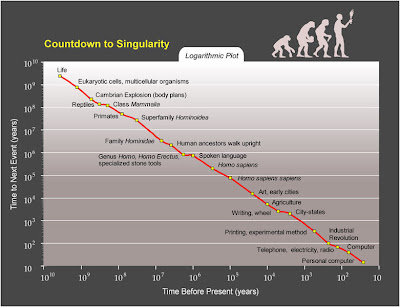Singularity
Moore's law describes an exponential growth pattern in the complexity of integrated semiconductor circuits. Kurzweil extended this to include technologies from far before the integrated circuit to future forms of computation. He declared that, whenever a technology approaches some kind of a barrier, a new technology will be invented to allow us to cross that barrier. He predicts that such paradigm shifts will become more and more common as time goes on. He believes that the exponential growth of Moore's law will continue beyond the use of integrated circuits into technologies that will lead to the "Singularity", which he defines as a technological change so rapid and profound it represents a rupture in the fabric of human history. According to Kurzweil, a new technology will be invented to allow us to cross that barrier. He believes the Law of Accelerating Returns implies that a technological singularity will occur before the end of the 21st century, in 2045.
Raymond Kurzweil, han propuesto teorías que expanden la Ley de Moore hacia tipos de computación que van más allá de los simples transistores, sugiriendo un patrón exponencial de progreso tecnológico que persiste a través de la historia humana (se toma en cuenta el poder de computación de los cerebros humanos), e incluso antes de que siquiera hubiera vida sobre la tierra. Según Kurzweil, este patrón culmina en un progreso tecnológico inimaginable en el Siglo XXI, el cual conduce a la Singularidad.
Kurzweil writes:
"An analysis of the history of technology shows that technological change is exponential, contrary to the common-sense 'intuitive linear' view. So we won't experience 100 years of progress in the twenty first century—it will be more like 20,000 years of progress (at today's rate). The 'returns,' such as chip speed and cost-effectiveness, also increase exponentially. There's even exponential growth in the rate of exponential growth. Within a few decades, machine intelligence will surpass human intelligence, leading to The Singularity—technological change so rapid and profound it represents a rupture in the fabric of human history. The implications include the merger of biological and nonbiological intelligence, immortal software-based humans, and ultra-high levels of intelligence that expand outward in the universe at the speed of light."
Bill Gates called Ray Kurzweil "the best at predicting the future of artificial intelligence".
Another of Kurzweil's charts shows exponential growth in supercomputer power and marks points at which he predicts human simulation will be possible.Kurzweil is also an enthusiastic advocate of using technology to achieve immortality. He advocates using nanobots to maintain the human body.
Fifteen views of evolution. Major paradigm shifts in the history of the world, as seen by fifteen different lists of key events. There is a clear trend of smooth acceleration though biological evolution and then technological evolution.
This graph, done by Ray Kurzweil, is based on data compiled by Theodore Modis, who "attempted to develop a precise mathematical law that governs the evolution of change and complexity in the Universe". To reduce bias, he compiled thirteen multiple independent lists of major events in the history of biology and technology from the following sources:
Singularidad tecnológica (algunas veces llamada simplemente la Singularidad) es un evento futuro en el que se predice que el progreso tecnológico y el cambio social acelerarán debido al desarrollo de inteligencia superhumana, cambiando nuestro ambiente de manera tal, que cualquier ser humano anterior a la Singularidad sería incapaz de comprender o predecir. Dicho evento se ha nombrado así por analogía con la singularidad gravitacional observada en los agujeros negros, donde existe un punto en el que las reglas de la física dejan de ser válidas, y donde la convergencia hacia valores infinitos hace imposible el definir una función.
Según el científico y escritor de ciencia ficción Vernor Vinge, la singularidad se puede alcanzar por diferentes caminos:
- El desarrollo de un computador que alcance el nivel de inteligencia humana y posteriormente lo supere.
- El desarrollo de redes de computadoras que se comporten como superneuronas de un cerebro distribuido que "despierte" como ente inteligente.
- El desarrollo de elementos de interacción con computadoras que permitan a un humano comportarse como un ser superinteligente.
- Manipulaciones biológicas que permitan mejorar en algunos seres el nivel humano de inteligencia.
El tiempo que resta antes de que se llegue a ese fenómeno se acelera con la utilización de máquinas para apoyar tareas de diseño o mejoras de diseño de nuevos inventos. Si la Singularidad ocurrirá o no, es un hecho muy debatido, pero la aproximación más común entre los futuristas la sitúa dentro de la tercera década del Siglo XXI.
http://www.kurzweilai.net/
(fuentes
- universidad de Stanford
- wikipedia
- kurzweilai
- singularity institute
)
1 comentario:
habia mucho mas para poner pero realmente me canse de hacer copy paste..
pd. y si esta en ingles y castellano, no rompais que el spanglish une. :P
Publicar un comentario